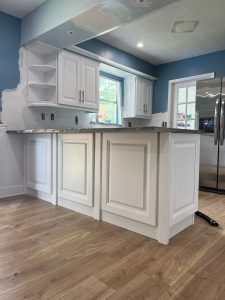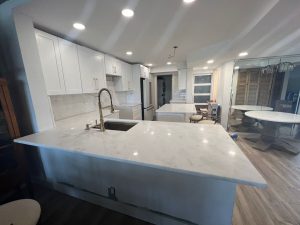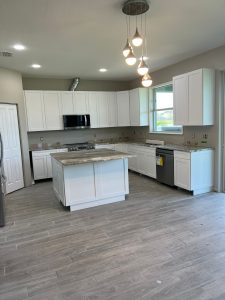Exploring the World of Kitchen Cabinets: From Design to Installation
When it comes to transforming your kitchen, kitchen cabinets play a crucial role. They not only provide essential storage space but also contribute to the overall aesthetic and functionality of the space. In this article, we will delve into the world of kitchen cabinets, from design to installation.

Designing Your Dream Kitchen Cabinets
The first step in creating your dream kitchen cabinets is designing them to fit your specific needs and preferences. Start by assessing your storage requirements and considering the layout of your kitchen. This will help you determine the cabinet size, type, and configuration that will work best for you.
Next, consider the style and materials you want for your cabinets. Whether you prefer a traditional, modern, or eclectic look, there are countless options available. Choose a color scheme that complements the rest of your kitchen décor and select materials that are both durable and aesthetically pleasing.

Choosing Quality Materials
Selecting high-quality materials is essential when investing in kitchen cabinets that will stand the test of time.
The Installation Process
Once the design and materials are finalized, it’s time for the installation process, hire professionals to ensure a flawless finish. Proper measuring, leveling, and securing of the cabinets are crucial to their stability and functionality.
Maintaining Your Kitchen Cabinets
To keep your kitchen cabinets looking good as new, regular maintenance is key. Wipe down the surfaces regularly with a mild cleaner and avoid using harsh abrasives that can damage the finish. Take care of any spills or stains promptly to prevent long-term damage. Additionally, periodically check and tighten any loose hinges or handles to ensure smooth operation.

Frequent Questions
What are the key factors to consider when choosing kitchen cabinets for optimal storage and functionality?
When choosing kitchen cabinets for optimal storage and functionality, there are several key factors to consider:
1. Layout and Design: Assess the layout of your kitchen and determine the most functional design for your cabinets. Consider factors such as the location of appliances, the work triangle, and the overall flow of the kitchen.
2. Storage Needs: Evaluate your storage requirements and prioritize the items you need to store. Consider the size and quantity of dishes, pots, pans, utensils, and appliances you have, as well as any specialty storage needs, such as wine racks or spice drawers.
3. Cabinet Style: Choose a cabinet style that complements your kitchen’s overall design theme. Decide between traditional, modern, or transitional styles, and consider the material, finish, and door style that best suits your taste.
4. Quality and Durability: Invest in high-quality cabinets that are built to last. Look for cabinets made from solid wood or plywood construction, sturdy hardware, and durable finishes. Consider brands with a reputation for producing long-lasting cabinets.
5. Organization Features: Look for cabinets that offer smart organizational features such as adjustable shelves, pull-out drawers, dividers, and built-in organizers. These features will help maximize your storage space and make it easier to access and organize your kitchen items.
6. Budget: Set a budget for your kitchen cabinets and stick to it. Remember to consider not only the upfront cost of the cabinets but also the long-term value they will provide in terms of functionality and durability.
7. Professional Installation: Consider hiring a professional cabinet installer to ensure that your cabinets are properly installed, aligned, and anchored. This will help prevent any issues in the future and ensure that your cabinets function optimally.
By considering these key factors, you can choose kitchen cabinets that provide optimal storage and functionality while enhancing the overall aesthetics of your kitchen.

How can I determine the best cabinet layout and configuration that will maximize space and efficiency in my kitchen?
When determining the best cabinet layout and configuration for your kitchen, there are several factors to consider:
1. Kitchen workflow: Consider the natural flow of movement in your kitchen. Place cabinets and appliances in a way that allows for easy access and efficient movement between different work areas, such as the stove, sink, and refrigerator.
2. Storage needs: Evaluate your storage needs based on the number of utensils, cookware, dishes, and pantry items you have. Consider whether you need more drawers, shelves, or specialized storage solutions like pull-out racks or lazy Susans.
3. Cabinet types: Choose the appropriate types of cabinets for different functions. For example, use base cabinets with deep drawers for pots and pans, wall cabinets for dishes and glassware, and tall cabinets for pantry items or broom storage.
4. Utilize vertical space: Maximize storage by utilizing the vertical space in your kitchen. Install taller wall cabinets that reach the ceiling, and consider adding open shelves or hanging racks for additional storage.
5. Consider ergonomics: Ensure that cabinets are installed at the appropriate heights for ease of use. Lower cabinets should be around 36 inches high, while upper cabinets are typically positioned at 54-60 inches above the floor.
6. Balance aesthetics and functionality: Choose cabinet styles and finishes that complement the overall design of your kitchen while still meeting your functional needs. Consider factors like durability, maintenance requirements, and your personal preferences.
7. Seek professional advice: If you’re unsure about the best layout and configuration for your kitchen cabinets, consider consulting with a kitchen designer or professional contractor who specializes in kitchen remodeling. They can provide expert guidance based on your specific needs and budget.
By considering these factors and customizing your cabinet layout to suit your unique requirements, you can maximize space and efficiency in your kitchen.

What are the latest trends and design options in kitchen cabinets, and how can I incorporate them into my home?
1. Open shelving: Open shelving provides a modern and airy feel to your kitchen. It allows you to display decorative items and easily access frequently-used objects.
2. Two-tone cabinets: Mixing different colored cabinets adds visual interest and depth to your kitchen. Consider combining white or light-colored upper cabinets with darker lower cabinets for a striking contrast.
3. Slab cabinet doors: Slab cabinet doors feature a flat, solid panel without any embellishments or detailing. This minimalist design is sleek and contemporary, giving your kitchen an effortlessly chic look.
4. Handleless cabinets: Handleless cabinets create a streamlined and seamless appearance. They often feature push-to-open mechanisms or recessed finger pulls for a sleek and modern design.
5. Glass-front cabinets: Glass-front cabinets provide an opportunity to showcase your favorite china, glassware, or decorative items. They add elegance and visual interest to your kitchen while still keeping items protected.
6. Mixed materials: Mixing different materials, such as wood and metal, can give your kitchen a unique and eclectic look. Consider incorporating metal accents or wood veneer panels for added texture and character.
7. Smart storage solutions: Incorporating innovative storage solutions, like pull-out drawers, vertical dividers, or custom organizers, can maximize space and improve functionality in your kitchen.
8. Customized cabinetry: Tailor-made cabinetry allows you to design your kitchen cabinets according to your specific needs and preferences. This ensures that every detail, from size to layout, is personalized for your space.
To incorporate these trends into your home, start by assessing your kitchen’s style and your own design preferences. Determine which trends align with your vision, and consult with a professional to ensure a seamless integration. Remember, it’s important to strike a balance between trendy elements and timeless designs to ensure longevity and appeal in the long run.
